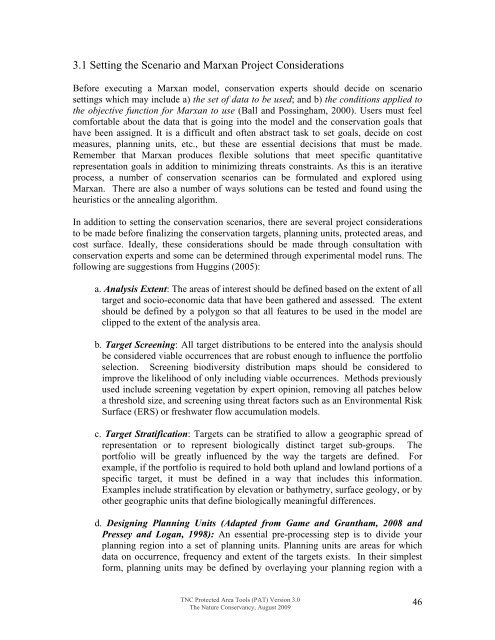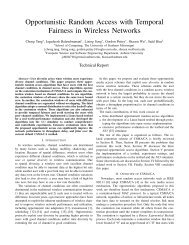Download the Tutorial
Download the Tutorial
Download the Tutorial
You also want an ePaper? Increase the reach of your titles
YUMPU automatically turns print PDFs into web optimized ePapers that Google loves.
3.1 Setting <strong>the</strong> Scenario and Marxan Project ConsiderationsBefore execut ing a Marxan model, conservation experts should decide on scenariosettings which may include a) <strong>the</strong> set of data to be used; and b) <strong>the</strong> conditions applied to<strong>the</strong> objective function for Marxan to use (Ball and Possingham, 2000). Users must feelcomfortable about <strong>the</strong> data that is going into <strong>the</strong> model and <strong>the</strong> conservation goals thathave been assigned. It is a difficult and often abstract task to set goals, decide on costmeasures, planning units, etc., but <strong>the</strong>se are essential decisions that must be made.Remember that Marxan produces flexible solutions that meet specific quantitativerepresentation goals in addition to minimizing threats constraints. As this is an iterativeprocess, a numberof conservation scenarios can be formulated and explored usingMarxan. There are also a number of ways solutions can be tested and found using <strong>the</strong>heuristics or <strong>the</strong> annealing algorithm.In addition to setting <strong>the</strong> conservation scenarios, <strong>the</strong>re are several project considerationsto be made before finalizing <strong>the</strong> conservation targets, planning units, protected areas, andcost surface. Ideally, <strong>the</strong>se considerations should be made through consultation withconservation experts and some can be determined through experimental model runs. Thefollowing are suggestions from Huggins (2005):a. Analysis Extent: The areas of interest should be defined based on <strong>the</strong> extent of alltarget and socio-economic data that have been ga<strong>the</strong>red and assessed. The extentshould be defined by a polygon so that all features to be used in <strong>the</strong> model areclipped to <strong>the</strong> extent of <strong>the</strong> analysis area.b. Target Screening: All target distributions to be entered into <strong>the</strong> analysis shouldbe considered viable occurrences that are robust enough to influence <strong>the</strong> portfolioselection. Screening biodiversity distribution maps should be considered toimprove <strong>the</strong> likelihood of only including viable occurrences. Methods previouslyused include screening vegetation by expert opinion, removing all patches belowa threshold size, and screening using threat factors such as an Environmental RiskSurface (ERS) or freshwater flow accumulation models.c. Target Stratification: Targets can be stratified to allow a geographic spread ofrepresentation or to represent biologically distinct target sub-groups. Theportfolio will be greatly influenced by <strong>the</strong> way <strong>the</strong> targets are defined. Forexample, if <strong>the</strong> portfolio is required to hold both upland and lowland portions of aspecific target, it must be defined in a way that includes this information.Examples include stratification by elevation or bathymetry, surface geology, or byo<strong>the</strong>r geographic units that define biologically meaningful differences.d. Designing Planning Units (Adapted from Game and Grantham, 2008 andPressey and Logan, 1998): An essential pre-processing step is to divide yourplanning region into a set of planning units. Planning units are areas for whichdata on occurrence, frequency and extent of <strong>the</strong> targets exists. In <strong>the</strong>ir simplestform, planning units may be defined by overlaying your planning region with aTNC Protected Area Tools (PAT) Version 3.0The Nature Conservancy, August 200946
















